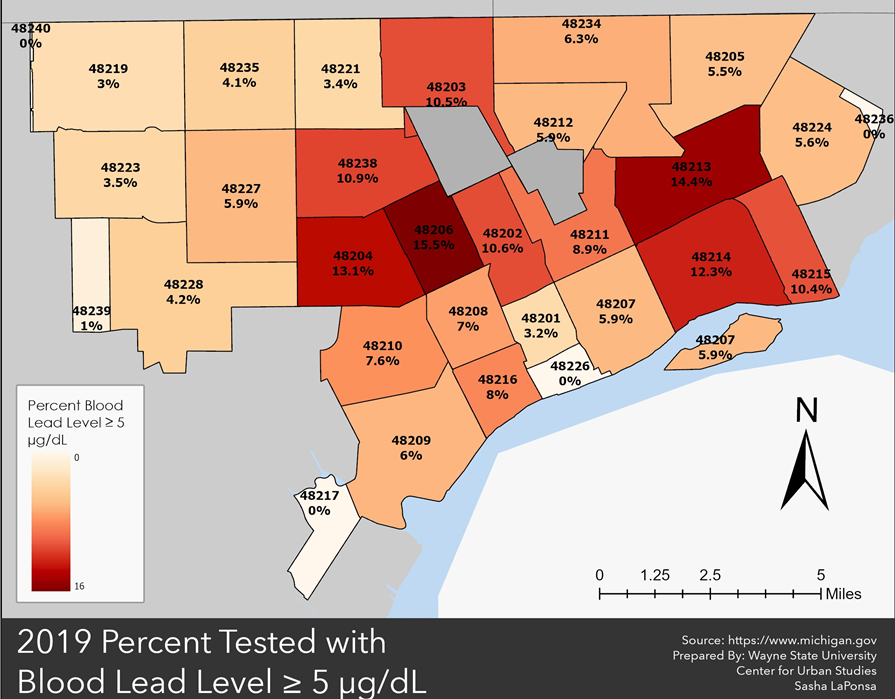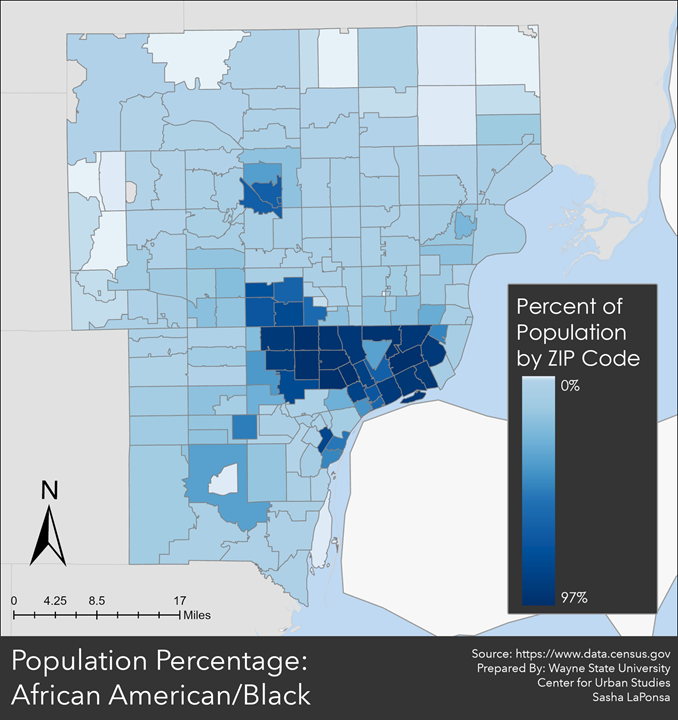In 2019, the Michigan Department of Health and Human Services (MDHHS) reported 1,299 children under 6 years old had Elevated Blood Lead Levels (EBLL) in the City of Detroit. The Detroit zip code with the highest percentage of children under the age of 6 with EBLL was 48206, which is located in the Boston Edison/Dexter Linwood area of the City. Here, 15.5 percent of tested children under the age of 6 had an EBLL. Overall, there were 8 zip codes in Detroit where 10 percent or more of tested children under the age of 6 had an EBLL. Furthermore, the number of children with EBLL is likely substantially under reported of the true number. This is because only a third of the eligible children are tested, so if all were tested, it is likely than many more would have an EBLL. In addition, testing has substantially decreased during the pandemic.
The 8 zip codes with EBLL above 10 percent in Detroit in 2019 were:
- 48202 (10.6%)
- 48203 (10.5%)
- 48204 (13.1%)
- 48206 (15.5%)
- 48213 (14.4%)
- 48214 (12.3%)
- 48215 (10.4%)
- 48238 (10.9%)
These neighborhoods are amongst the oldest residential neighborhoods in the Detroit-Metro area. And, with a few exceptions, the zip codes with high numbers of children with EBLL have high percentages of black residents. The first map below shows the zip codes in Detroit with the percentage of children under the age of 6 with EBLL; the second map shows the percentage of black residents in Detroit and Metro-Detroit. The overlap is apparent.


According to the Centers for Disease Control and Prevention (CDC), there is no safe level of lead, and even a small amount can cause irreversible damage. Yet, in Detroit several areas continue to be plagued with by lead exposure. There are several reasons behind this, many of which are impacted by income, poverty, access to safe and updated housing.
Lead paint was banned from use in 1978 yet there are more than 337,000 homes in Detroit built before 1980 (when lead paint came off the shelves), according to Census data. Additionally, income directly impacts what type of housing an individual and/or a family can afford. With a median income of $31,000 and 35 percent of families in the City living at or below the poverty level it is fair to suggest that many families are living in older, less expensive housing where hazardous issues are likely more prevalent, and these families cannot afford the $20,000 to $40,000 cost of abating the major lead hazards in the home. Lead paint is a top contributor to lead poisoning and without it being mitigated, lead poisoning will continue. Additionally, some children are lead poisoned through soil, spices, pottery and water. Also, leaded gasoline and demolitions have added lead dust to the soils in Detroit.
Children’s cognitive and physical health will continue to be impacted without mitigation of lead poisoning and its causes, specifically lead paint remaining in homes throughout the City. Children with EBLL can be impacted by the following side effects of the neurotoxin of lead:
•Decreased Intelligence
•Decreased impulse control and thus increases reactivity
•Calcium deficiencies
•ADHD and Behavioral issues
•Osteoporosis
•Decreased school performance
•Permanent damage to kidneys and the heart
Concerns over lead poisoning and the resources needed to eliminate it have long been a topic of discussion, however without funding there can be no action. Funding needs to be direct and plentiful as well. So a multi-faceted plan needs to provide regular lead testing, funding for lead abatement, and relocation means to get families out of homes that aren’t worth salvaging and into safer ones. Lead abatement and housing relocation programs exist, but the necessary funding to make a greater impact and create long-term sustainability clear has not been realized.
Long-term funding and policies to reduce and eventually eliminate lead poisoning should include:
•Universal blood lead testing for all children under 6 in each County in Southeast Michigan;
•A required Lead Investigation/Risk Assessment (LI/RA) for all homes at sale (for homes built before 1980) and required abatement of hazards, when they are found.
•A requirement for all landlords to complete a LI/RA and abate all hazards for homes older than 1980.
•An increase in the home abatements in Metro-Detroit by 400-500% annually.
•The financial and programmatic ability to support the relocation of several hundred households a year, where abatement is not available for their homes.
•A cleaning program for homes where children or pregnant women are living, and/or where a child has been identified with an EBLL or the home has lead paint hazards. This program would provide ongoing training and support to teach and incentivize families to super clean their homes until their home can be abated or until the family can relocate.






